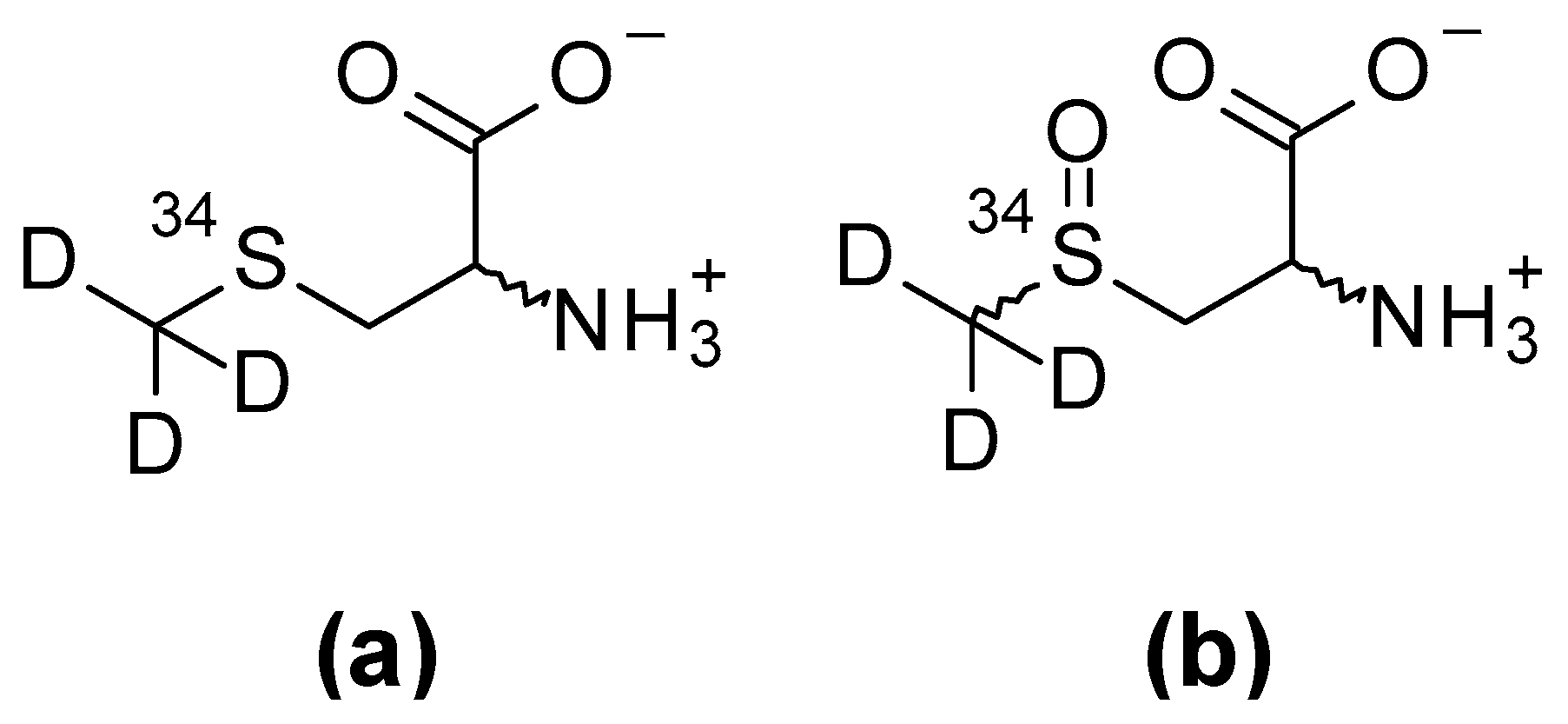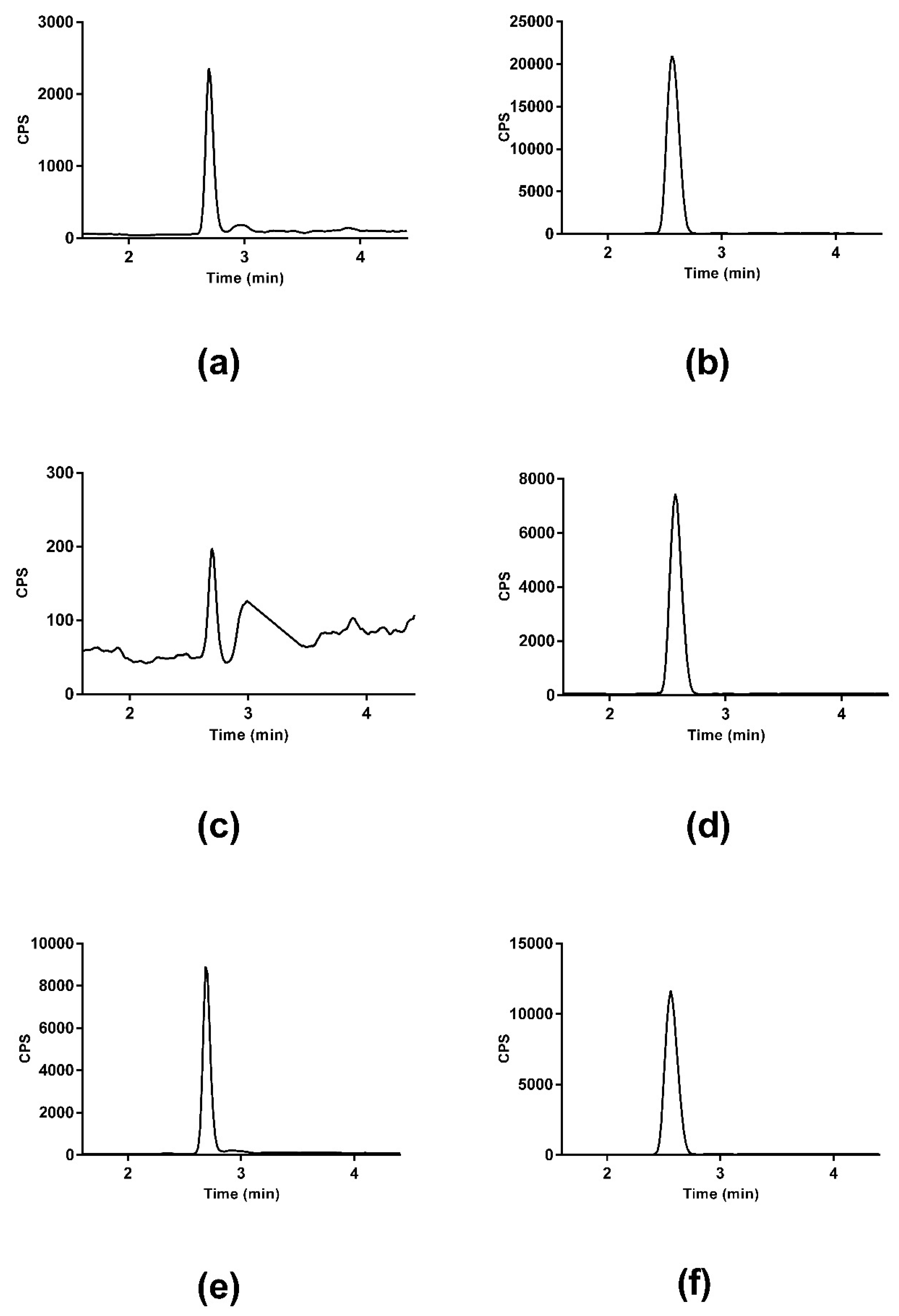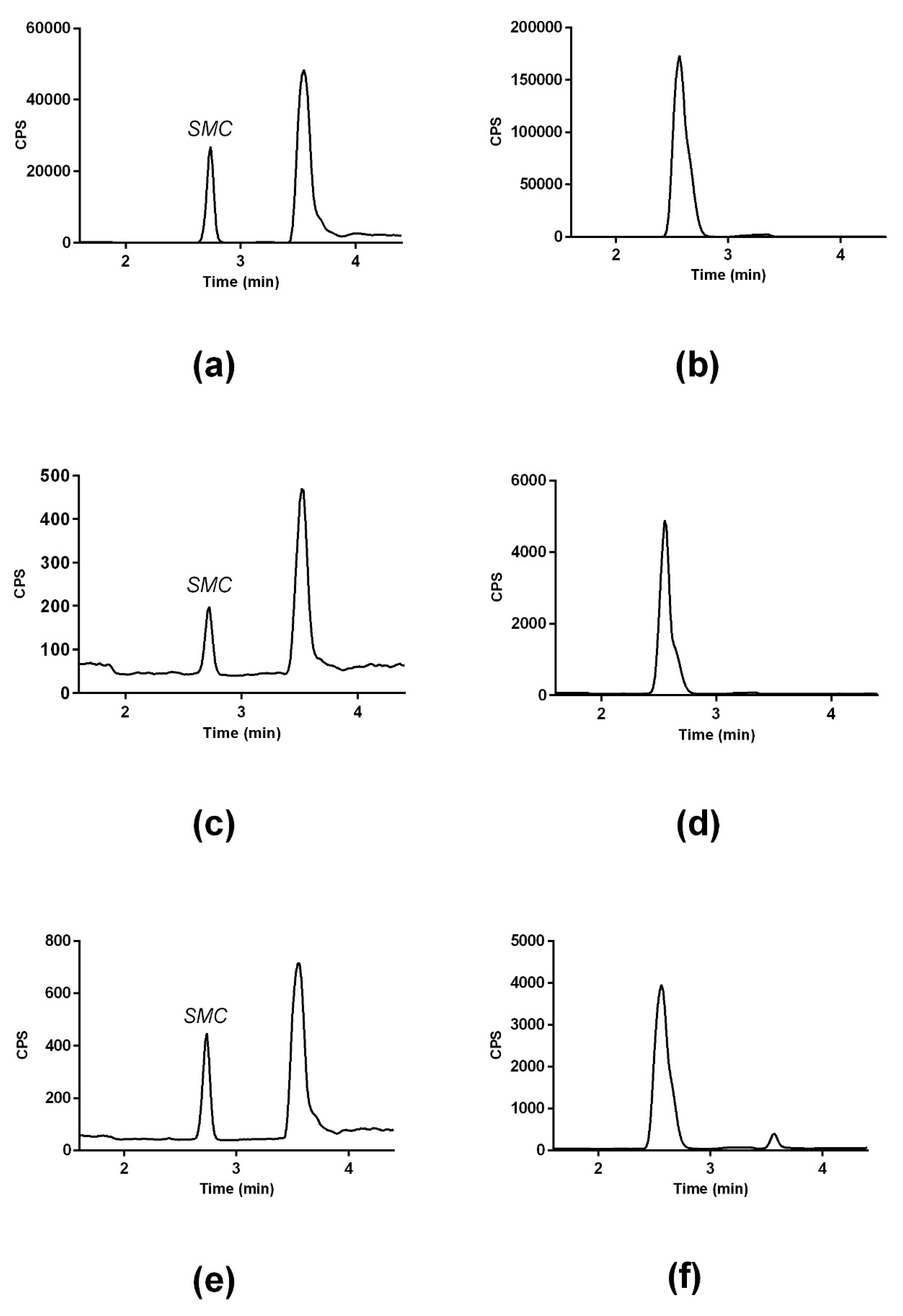An LC-MS/MS Method to Measure S-Methyl-l-Cysteine and S-Methyl-l-Cysteine Sulfoxide in Human Specimens Using Isotope Labelled Internal Standards
Abstract
1. Introduction
2. Results
2.1. Synthesis of Internal Standards
2.1.1. Identification of 34S-Trideuteromethylcysteine by 1H-NMR/δ (D2O) and Mass Spectroscopy
2.1.2. Identification of 34S-Trideuteromethylcysteine Sulfoxide by 1H-NMR/δ (D2O) and Mass Spectroscopy
2.2. Optimization of Mass Spectroscopy Conditions
2.3. Optimization of LC Parameters
2.4. Method Validation
2.4.1. Linearity and Sensitivity
2.4.2. Precision and Accuracy
2.4.3. Carry-Over Effect
2.4.4. Extraction Recovery and Matrix Effect
2.4.5. Sample Stability
2.5. Quantification of SMC and SMCSO in Urine Samples
2.6. Quantification of SMC and SMCSO in Plasma Samples
3. Discussion
4. Materials and Methods
4.1. Chemical and Reagents
4.2. Isotope Labelled Internal Standards (34S-Trideuteromethylcysteine and 34S-Trideuteromethylcysteine Sulfoxide)
4.3. Human Body Fluids
4.4. LC-MS/MS Analysis
4.5. Analytical Validation
4.5.1. Linearity
4.5.2. Sensitivity
4.5.3. Precision and Accuracy
4.5.4. Carry-Over Effect
4.5.5. Extraction Recovery and Matrix Effect (or Ion Suppression)
4.6. Data Analysis
4.7. Ethical Considerations
5. Conclusions
Author Contributions
Funding
Conflicts of Interest
References
- Doleman, J.F.; Grisar, K.; Van Liedekerke, L.; Saha, S.; Roe, M.; Tapp, H.S.; Mithen, R.F. The contribution of alliaceous and cruciferous vegetables to dietary sulphur intake. Food Chem. 2017, 234, 38–45. [Google Scholar] [CrossRef] [PubMed]
- Ingenbleek, Y.; Kimura, H. Nutritional essentiality of sulfur in health and disease. Nutr. Rev. 2013, 71, 413–432. [Google Scholar] [CrossRef] [PubMed]
- Nicastro, H.L.; Ross, S.A.; Milner, J.A. Garlic and onions: Their cancer prevention properties. Cancer Prev. Res. 2015, 8, 181–189. [Google Scholar] [CrossRef] [PubMed]
- Herr, I.; Büchler, M.W. Dietary constituents of broccoli and other cruciferous vegetables: Implications for prevention and therapy of cancer. Cancer Treat. Rev. 2010, 36, 377–383. [Google Scholar] [CrossRef] [PubMed]
- Sivapalan, T.; Melchini, A.; Saha, S.; Needs, P.W.; Traka, M.H.; Tapp, H.; Dainty, J.R.; Mithen, R.F. Bioavailability of Glucoraphanin and Sulforaphane from High-Glucoraphanin Broccoli. Mol. Nutr. Food Res. 2018, 62, e1700911. [Google Scholar] [CrossRef] [PubMed]
- Komatsu, W.; Miura, Y.; Yagasaki, K. Suppression of hypercholesterolemia in hepatoma-bearing rats by cabbage extract and its component, S-methyl-l-cysteine sulfoxide. Lipids 1998, 33, 499–503. [Google Scholar] [CrossRef] [PubMed]
- Fleming, H.P.; Kyung, K.H. Antimicrobial Activity-of Sulfur Compounds Derived from Cabbage. J. Food Prot. 1997, 60, 67–71. [Google Scholar]
- Yoshinari, O.; Shiojima, Y.; Igarashi, K. Anti-Obesity Effects of Onion Extract in Zucker Diabetic Fatty Rats. Nutrients 2012, 4, 1518–1526. [Google Scholar] [CrossRef] [PubMed]
- Edmands, W.M.B.; Gooderham, N.J.; Holmes, E.; Mitchell, S.C. S-Methyl-l-cysteine sulphoxide: the Cinderella phytochemical? Toxicol. Res. 2013, 2, 11–22. [Google Scholar] [CrossRef]
- Keusgen, M.; Schulz, H.; Glodek, J.; Krest, I.; Krüger, H.; Herchert, N.; Keller, J. Characterization of SomeAlliumHybrids by Aroma Precursors, Aroma Profiles, and Alliinase Activity. J. Agric. Food Chem. 2002, 50, 2884–2890. [Google Scholar] [CrossRef]
- Krest, I.; Glodek, J.; Keusgen, M. Cysteine Sulfoxides and Alliinase Activity of SomeAlliumSpecies. J. Agric. Food Chem. 2000, 48, 3753–3760. [Google Scholar] [CrossRef] [PubMed]
- Montaño, A.; Beato, V.M.; Mansilla, F.; Orgaz, F. Effect of Genetic Characteristics and Environmental Factors on Organosulfur Compounds in Garlic (Allium sativum L.) Grown in Andalusia, Spain. J. Agric. Food Chem. 2011, 59, 1301–1307. [Google Scholar] [CrossRef]
- Arnold, W.N.; Thompson, J.F. The formation of (+) S-methyl-l-cysteine sulfoxide from S-methyl-l-cysteine in crucifers. Biochim. et Biophys. Acta 1962, 57, 604–606. [Google Scholar] [CrossRef]
- Edmands, W.M.B.; Beckonert, O.P.; Stella, C.; Campbell, A.; Lake, B.G.; Lindon, J.C.; Holmes, E.; Gooderham, N.J. Identification of Human Urinary Biomarkers of Cruciferous Vegetable Consumption by Metabonomic Profiling. J. Proteome Res. 2011, 10, 4513–4521. [Google Scholar] [CrossRef] [PubMed]
- Block, E.; Dane, A.J.; Thomas, S.; Cody, R.B. Applications of Direct Analysis in Real Time Mass Spectrometry (DART-MS) in Allium Chemistry. 2-Propenesulfenic and 2-Propenesulfinic Acids, Diallyl TrisulfaneS-Oxide, and Other Reactive Sulfur Compounds from Crushed Garlic and Other Alliums. J. Agric. Food Chem. 2010, 58, 4617–4625. [Google Scholar] [CrossRef]
- Horie, H.; Yamashita, K.-I. Non-derivatized analysis of methiin and alliin in vegetables by capillary electrophoresis. J. Chromatogr. A 2006, 1132, 337–339. [Google Scholar] [CrossRef] [PubMed]
- Ichikawa, M.; Ide, N.; Yoshida, J.; Yamaguchi, H.; Ono, K. Determination of Seven Organosulfur Compounds in Garlic by High-Performance Liquid Chromatography. J. Agric. Food Chem. 2006, 54, 1535–1540. [Google Scholar] [CrossRef]
- Kellingray, L.; Tapp, H.S.; Saha, S.; Doleman, J.F.; Narbad, A.; Mithen, R.F. Consumption of a diet rich in Brassica vegetables is associated with a reduced abundance of sulphate-reducing bacteria: A randomised crossover study. Mol. Nutr. Food Res. 2017, 61, 1600992. [Google Scholar] [CrossRef]
- Kubec, R.; Dadáková, E. Quantitative determination of S-alk(en)ylcysteine-S-oxides by micellar electrokinetic capillary chromatography. J. Chromatogr. A 2008, 1212, 154–157. [Google Scholar] [CrossRef]
- Kubec, R.; Svobodová, M.; Velíšek, J. Gas chromatographic determination of S-alk(en)ylcysteine sulfoxides. J. Chromatogr. A 1999, 862, 85–94. [Google Scholar] [CrossRef]
- Kubec, R.; Svobodová, M.; Velíšek, J. Gas-chromatographic determination of S-methylcysteine sulfoxide in cruciferous vegetables. Eur. Food Res. Technol. 2001, 213, 386–388. [Google Scholar] [CrossRef]
- Tsuge, K.; Kataoka, M.; Seto, Y. Determination of S-methyl-, S-propyl-, and S-propenyl-l-cysteine sulfoxides by gas chromatography-mass spectrometry after tert-butyldimethylsilylation. J. Agric. Food Chem. 2002, 50, 4445–4451. [Google Scholar] [CrossRef] [PubMed]
- Fatih, E.; Karim, I.A.; Millership, J.S.; Temple, D.J.; Woolfson, A.D. An investigation of the metabolism of S-carboxymethyl-l-cysteine in man using a novel HPLC-ECD method. Eur. J. Drug Metab. Pharmacokinet. 1988, 13, 253–256. [Google Scholar] [CrossRef] [PubMed]
- Kubec, R.; Svobodová, M.; Velíšek, J. Distribution of S-Alk(en)ylcysteine Sulfoxides in Some Allium Species. Identification of a New Flavor Precursor: S-Ethylcysteine Sulfoxide (Ethiin). J. Agric. Food Chem. 2000, 48, 428–433. [Google Scholar] [CrossRef] [PubMed]
- Mitchell, S.; Waring, R.; Harris, R.; Steventon, G. Degradation to Sulphate of S-Methyl-l-Cysteine Sulphoxide and S-Carboxymethyl-l-Cysteine Sulphoxide in Man. Drug Metab. Drug Interactions 2003, 19, 241–256. [Google Scholar]
- Bernaert, N.; Goetghebeur, L.; De Clercq, H.; Van Pamel, E.; De Loose, M.; Daeseleire, E.; Van Bockstaele, E.; Van Droogenbroeck, B. Influence of Cultivar and Harvest Time on the Amounts of Isoalliin and Methiin in Leek (Allium ampeloprasum var. porrum). J. Agric. Food Chem. 2012, 60, 10910–10919. [Google Scholar] [CrossRef] [PubMed]
- Kim, S.; Park, S.-L.; Lee, S.; Lee, S.-Y.; Ko, S.; Yoo, M. UPLC/ESI-MS/MS analysis of compositional changes for organosulfur compounds in garlic (Allium sativum L.) during fermentation. Food Chem. 2016, 211, 555–559. [Google Scholar] [CrossRef]
- Kim, S.; Lee, S.; Shin, D.; Yoo, M. Change in organosulfur compounds in onion (Allium cepa L.) during heat treatment. Food Sci. Biotechnol. 2016, 25, 115–119. [Google Scholar] [CrossRef]
- Lundegardh, B.; Botek, P.; Schulzov, V.; Hajslov, J.; Stromberg, A.; Andersson, H.C. Impact of different green manures on the content of S-alk(en)yl-l-cysteine sulfoxides and l-ascorbic acid in leek (Allium porrum). J. Agric. Food Chem. 2008, 56, 2102–2111. [Google Scholar] [CrossRef]
- Kubec, R.; Cody, R.B.; Dane, A.J.; Musah, R.A.; Schraml, J.; Vattekkatte, A.; Block, E. Applications of Direct Analysis in Real Time−Mass Spectrometry (DART-MS) inAlliumChemistry. (Z)-ButanethialS-Oxide and 1-Butenyl Thiosulfinates and TheirS-(E)-1-ButenylcysteineS-Oxide Precursor from Allium siculum. J. Agric. Food Chem. 2010, 58, 1121–1128. [Google Scholar] [CrossRef]
- Kubec, R.; Dadáková, E. Chromatographic methods for determination of S-substituted cysteine derivatives—A comparative study. J. Chromatogr. A 2009, 1216, 6957–6963. [Google Scholar] [CrossRef]
- Westrop, G.D.; Wang, L.; Blackburn, G.J.; Zhang, T.; Zheng, L.; Watson, D.G.; Coombs, G.H. Metabolomic profiling and stable isotope labelling of Trichomonas vaginalis and Tritrichomonas foetus reveal major differences in amino acid metabolism including the production of 2-hydroxyisocaproic acid, cystathionine and S-methylcysteine. PLoS ONE 2017, 12, e0189072. [Google Scholar] [CrossRef] [PubMed]
- Amano, H.; Kazamori, D.; Itoh, K. Pharmacokinetics and N-acetylation metabolism of S-methyl-l-cysteine and trans-S-1-propenyl-l-cysteine in rats and dogs. Xenobiotica 2016, 46, 1–9. [Google Scholar] [CrossRef] [PubMed]
- Rubino, F.M.; Pitton, M.; Di Fabio, D.; Meroni, G.; Santaniello, E.; Caneva, E.; Pappini, M.; Colombi, A. Measurement of S-methylcysteine and S-methyl-mercapturic acid in human urine by alkyl-chloroformate extractive derivatization and isotope-dilution gas chromatography-mass spectrometry. Biomed. Chromatogr. 2011, 25, 330–343. [Google Scholar] [CrossRef] [PubMed]
- Sargent, M. Guide to Achieving Reliable Quantitative LC-MS Measurements, 1st ed.; RSC Analytical Methods Committee: Cambridge, UK, 2013; pp. 1–61. [Google Scholar]
- Van de Merbel, N.C. Quantitative determination of endogenous compounds in biological samples using chromatographic techniques. TrAC 2008, 27, 924–933. [Google Scholar] [CrossRef]
- Armstrong, M.D. N-delta-acetylornithine and S-methylcysteine in blood plasma. Biochim. et Biophys. Acta. 1979, 587, 638–642. [Google Scholar] [CrossRef]
- Al Kadhi, O.; Melchini, A.; Mithen, R.; Saha, S. Development of a LC-MS/MS Method for the Simultaneous Detection of Tricarboxylic Acid Cycle Intermediates in a Range of Biological Matrices. J. Anal. Methods Chem. 2017, 2017, 1–12. [Google Scholar] [CrossRef]
- Mitchell, S.C.; Smith, R.L.; Waring, R.H.; Aldington, G.F. The metabolism of S-methyl-l-cysteine in man. Xenobiotica 1984, 14, 767–779. [Google Scholar] [CrossRef]
- Barry, T.N.; Manley, T.R.; Millar, K.R. Nutritional evaluation of kale (Brassica oleracea) diets:4. Responses to supplementation with synthetic S-methyl-l-cysteine sulphoxide (SMCO). J. Agric. Sci. 2009, 99, 1–12. [Google Scholar] [CrossRef]
Sample Availability: Samples of the compounds are not available from the authors. |



| Analyte | Retention Time (mins) | Precursor Ion (m/z) | Product Ion (m/z) | Collision Energy | Cell Accelerator Energy | Polarity |
|---|---|---|---|---|---|---|
| SMCSO | 2.6 | 152.19 | 87.9 | 4 | 4 | Positive |
| SMCSO | 2.6 | 152.19 | 69.9 | 16 | 4 | Positive |
| SMCSO | 2.6 | 152.19 | 42.1 | 20 | 4 | Positive |
| SMC | 2.7 | 136.19 | 119.1 | 10 | 4 | Positive |
| SMC | 2.7 | 136.19 | 47 | 34 | 4 | Positive |
| 34S-d3SMCSO | 2.6 | 157.05 | 87.9 | 8 | 4 | Positive |
| 34S-d3SMCSO | 2.6 | 157.05 | 42.1 | 28 | 4 | Positive |
| 34S-d3SMC | 2.7 | 141.06 | 124 | 10 | 4 | Positive |
| 34S-d3SMC | 2.7 | 141.06 | 42.1 | 30 | 4 | Positive |
| Analyte | R2 | Precision (n = 5) (Intra-Day) R.S.D. % | Precision (n = 5) (Inter-Day) R.S.D. % | Accuracy (% Recovery) | LOD (µM) | LOQ (µM) | ||||||
|---|---|---|---|---|---|---|---|---|---|---|---|---|
| L | M | H | L | M | H | L | M | H | ||||
| SMC (Urine) | 0.9998 | 9.44 | 2.00 | 5.13 | 9.19 | 8.17 | 5.28 | 82.8 | 101 | 101 | 0.08 | 0.24 |
| SMC (Plasma) | 0.9987 | 8.8 | 6.8 | 7.2 | 11.29 | 7.81 | 7.16 | 97.7 | 97.0 | 95.49 | 0.04 | 0.12 |
| SMCSO (Urine) | 0.9995 | 5.49 | 5.14 | 5.43 | 14.36 | 7.11 | 5.50 | 100.4 | 105.98 | 101.2 | 0.03 | 0.09 |
| SMCSO (Plasma) | 0.9989 | 8.86 | 2.1 | 4.8 | 19.80 | 10.69 | 6.72 | 99.64 | 99.38 | 97.77 | 0.02 | 0.06 |
© 2019 by the authors. Licensee MDPI, Basel, Switzerland. This article is an open access article distributed under the terms and conditions of the Creative Commons Attribution (CC BY) license (http://creativecommons.org/licenses/by/4.0/).
Share and Cite
Sivapalan, T.; Melchini, A.; Coode-Bate, J.; Needs, P.W.; Mithen, R.F.; Saha, S. An LC-MS/MS Method to Measure S-Methyl-l-Cysteine and S-Methyl-l-Cysteine Sulfoxide in Human Specimens Using Isotope Labelled Internal Standards. Molecules 2019, 24, 2427. https://doi.org/10.3390/molecules24132427
Sivapalan T, Melchini A, Coode-Bate J, Needs PW, Mithen RF, Saha S. An LC-MS/MS Method to Measure S-Methyl-l-Cysteine and S-Methyl-l-Cysteine Sulfoxide in Human Specimens Using Isotope Labelled Internal Standards. Molecules. 2019; 24(13):2427. https://doi.org/10.3390/molecules24132427
Chicago/Turabian StyleSivapalan, Tharsini, Antonietta Melchini, Jack Coode-Bate, Paul W. Needs, Richard F. Mithen, and Shikha Saha. 2019. "An LC-MS/MS Method to Measure S-Methyl-l-Cysteine and S-Methyl-l-Cysteine Sulfoxide in Human Specimens Using Isotope Labelled Internal Standards" Molecules 24, no. 13: 2427. https://doi.org/10.3390/molecules24132427
APA StyleSivapalan, T., Melchini, A., Coode-Bate, J., Needs, P. W., Mithen, R. F., & Saha, S. (2019). An LC-MS/MS Method to Measure S-Methyl-l-Cysteine and S-Methyl-l-Cysteine Sulfoxide in Human Specimens Using Isotope Labelled Internal Standards. Molecules, 24(13), 2427. https://doi.org/10.3390/molecules24132427




